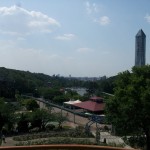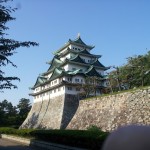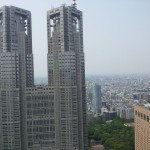Today it is/will be announced that the Large Hadron Collider (LHC) accelerator experiment near Geneva has observed the Higgs particle. Although in not my field of expertise, this is a huge discovery in physics, and I will write about it here. Probably some more updates will follow today and later, at the end of this post.
What is the Higgs particle?
Most importantly it is the single missing piece in the puzzle of fundamental particles that is called the Standard Model. This model was developed in the 1960s and on, and makes very precise predictions on which fundamental particles exist, and how they interact. Roughly there are two kinds of partices: matter particles and force particles.
The matter particles comprise quarks (building blocks of protons an neutrons that make up atomic nuclei), electrons and the elusive neutrinos. They all have mass. The force particles cause the matter particles to interact with each other. For instance the electromagnetic force is mediated by light particles, called photons. The force particles are of themselves massless, which is also the reason why photons travel at the maximum velocity, therefore known as the speed of light.
Now it comes: there is yet one other particle, which is unlike all the others. This is the Higgs particle. It does not mediate a force by itself, but instead interacts with the other force particles. When this happens, that force turns from a long-range force to a short-range force. Light does not interact with Higgs, and therefore we can feel a tiny force from stars billions of light years away. The particles that make up the weak nuclear force, responsible for radioactive decay, and unimaginatively called W- and Z-bosons, do interact with Higgs, and therefore only operate within say the atomic nucleus. In physics, this turning into a short-range force is completely equivalent with the force particle “obtaining a mass”, so turning from a massless into a massive particle. This is reason why you can read statement like “Higgs gives mass to all other particles”. The Higgs particle also interacts with some matter particles, but since they are already massive, their mass just gets a little bit bigger.
Bottom line: the fact that the last piece of the puzzle is found is of prime importance, all hyped claims like “God particle” and what not should not be taken seriously.
Interestingly, in precisely the same way as I described above, a magnetic field dies off over a short length in a superconductor, so turns from long-range to short-range. In this context it is called the Anderson-Higgs mechanism, and it is of central importance in my thesis work.
What does an accelerator do?
The big accelerator ring on the Swiss/French border was upgraded some years ago, and was, after an unfortunate accident in 2008, fully operational in 2010. In this ring protons (the nucleus of a hydrogen atom) are accelerated to near light speed in two opposite directions (there are two pipes). At four places these two beams can be made to intersect, such that protons from one beam collide with those from the other.
What happens basically is that two protons combine into a lump of energy, which immediately after splits up into other particles. More precisely, the quarks within the proton do this. They can turn into other quarks, neutrinos, other stuff, and also into the Higgs particle, according to the very precise rules laid out by the Standard model. Those resultant particles then fly away from the collision center and into the detectors. Those are huge instruments to be thought of as the CCD element in your digital camera. They notice when a particle hits them, and can also measure their energy and momentum, like your camera can measure the colour.
However, most of the produced particles including the Higgs are terribly unstable and quickly decay into other particles. So what the detectors measure is not the Higgs particle itself, but remnants of it. Because there is so much going on, so many collisions at the same time, the detectors collect a huge amount of data. This is then processed, first by discarding about 99% of it. The relevant data is analyzed by many people and big computers, and finally interpreted by statistics.
People who’ve ever done something with statistics, know there is always noise. Apart from errors, there are just a lot of random events, for instance particles from space, that your detectors pick up. The real particle collisions add just a few events on top of all of those random ones. So what you have to do is keep measuring and accumulate data, so that the real events start to outnumber the random ones. If there really is a particle that you are interested in, then you look for the predicted collision products with the predicted energy in the predicted directions, and see whether you eventually see a “signal” arising out of the noise.
This signal is compared to computer simulations/calculations based on the Standard Model. These simulations are done beforehand, so people know that if they see a signal, they know to what particular collision process it can be attributed.
In short: you can never see the Higgs particle itself, you can only accumulate evidence that it must have been there.
What has been discovered now?
As mentioned, all particles predicted by the Standard Model have been found except for the Higgs. Therefore the upgrade to the LHC was geared specifically to finding the Higgs (but also other things are researched). Two experiments, ATLAS and CMS, each and independently look for different collision processes involving the Higgs.
One major problem is that the Standard Model does not predict the mass of the Higgs particle itself (but once you know the mass, the interactions it can undergo are predicted with high precision). Therefore the experiment had to look for all the possibilities that Higgs particles of different mass may incur. This is done by looking for the collision products that should occur. If with statistical certainty they are not there, then you have “excluded the existence of a Higgs particle with mass x“. Then you do the same for other mass values. In the end you exclude whole mass regions, and this has been done over the past few decades. Of course what you hope for is that the data contradicts the hypothesis that the particle is not there. If that happens with enough certainty, you claim discovery of the particle.
There is a terminology in particle physics, where the “observation” of a particle denotes less certainty than the “discovery” of it. Today they will probably announce “observation of a Higgs particle with mass around 125 GeV”. Most people are however now convinced that this will not be overturned. This is the greatest physics achievement of this decade, probably of all of science. It is also amazing that a particle predicted in 1964 is now finally confirmed.
What’s next?
First of all, they have to very carefully study the Higgs and check against the Standard Model. There are many properties and interactions, for which there are precise predicitons, to which the Higgs particle should conform. It is not at all certain that this will the case, and there may even be more than one variety of the Higgs particle. Also the Higgs may not be fundamental but consist of other particle itself.
If after all this the conclusion is that there is precisely one variety of Higgs particle which conforms exactly to the Standard Model, and no other particles are found either, then we face a conundrum. Namely, the Standard Model has known problems, it does not explain everything in the world around us. For instance, gravity is not part of it! Search for solutions to these problems is called Beyond the Standard Model physics. The LHC will continue to look for anything that can help answer those questions.
Links
If you have time to spare, you can watch excited nerds talking in an alien language at the CERN live webcast. The best source for physicists is probably Tomasso Dorigo’s live blogging. And don’t believe everything you read and hear in regular media.
Press releases: CERN — NIKHEF
I will try to answer questions you may have, in English or Dutch.
Update 5 Jul 11:00JST To be clear about what has been found: both the ATLAS and the CMS experiment see clear evidence with just about enough statistical signficance to claim discovery, for a new, hitherto unobserved particle with a mass of about 126 GeV. The observed behaviour of this particle agrees with what a Standard Model Higgs particle would do, but there is not enough data to unambiguously claim that it is the Higgs. However, we can invoke the duck theorem here: if walks, talks and quacks like a duck, it’s probably a duck.
There is a slight deviation in the so-called two-photon-to-Higgs decay channel, they observe more of those events than one would expect from the number of collisions that have occurred. This may be a statistical fluctuation (the number of events is quite small, just several hundreds), or it may be a real effect that the Standard Model cannot explain. People are hoping for the latter, as it might give a clue in answering the unsolved problems.




Recent Comments